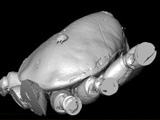|
|
TODAY.AZ / Weird / Interesting
Hi-Tech scans catch prehistoric mite hitching ride on spider
09 November 2011 [13:40] - TODAY.AZ
 Scientists at the University of Manchester colleagues in Berlin believe have produced amazing three-dimensional images of a prehistoric mite as it hitched a ride on the back of a 50 million-year-old spider.
Scientists at the University of Manchester colleagues in Berlin believe have produced amazing three-dimensional images of a prehistoric mite as it hitched a ride on the back of a 50 million-year-old spider.At just 176 micrometres long and barely visible to the naked eye, the mite -- trapped inside Baltic amber (fossil tree resin) -- is believed to be the smallest arthropod fossil ever to be scanned using X-ray computed tomography (CT) scanning techniques.
The study, published in the Royal Society journal Biology Letters, also sets a minimum age of almost 50 million years for the evolution among these mites of phoretic, or hitchhiking, behaviour using another animal species.
"CT allowed us to digitally dissect the mite off the spider in order to reveal the important features on the underside of the mite required for identification," said Dr David Penney, one of the study's authors based in the Faculty of Life Sciences. "The specimen, which is extremely rare in the fossil record, is potentially the oldest record of the living family Histiostomatidae.
"Amber is a remarkable repository of ecological associations within the fossil record. In many cases organisms died instantaneously and were preserved with lifelike fidelity, still enacting their behaviour immediately prior to their unexpected demise. We often refer to this as 'frozen behaviour' or palaeoethology and such examples can tell us a great deal about interactions in ecosystems of the past. However, most amber fossils consist of individual insects or several insects together but without unequivocal demonstrable evidence of direct interaction. The remarkable specimen we describe in this paper is the kind of find that occurs only once in say a hundred thousand specimens."
Fellow Manchester biologist Dr Richard Preziosi said: "Phoresy is where one organism uses another animal of a different species for transportation to a new environment. Such behaviour is common in several different groups today. The study of fossils such as the one we described can provide important clues as to how far back in geological time such behaviours evolved. The fact that we now have technology that was unavailable just a few years ago means we can now use a multidisciplinary approach to extract the most information possible from such tiny and awkwardly positioned fossils, which previously would have yielded little or no substantial scientific data."
Co-author Professor Phil Withers, from Manchester's School of Materials, said: "We believe this to be the smallest amber inclusion scanned anywhere to date. With our sub-micron phase contrast system we can obtain fantastic 3D images and compete with synchrotron x-ray systems and are revealing fossils previously inaccessible to imaging. With our nanoCT lab systems, we are now looking to push the boundaries of this technique yet further."
Dr Jason Dunlop, from the Humboldt University, Berlin, added: "As everyone knows, mites are usually very small animals, and even living ones are difficult to work with. Fossil mites are especially rare and the particular group to which this remarkable new amber specimen belongs has only been found a handful of times in the fossil record. Yet thanks to these new techniques, we could identify numerous important features as if we were looking at a modern animal under the scanning electron microscope. Work like this is breaking down the barriers between palaeontology and zoology even further."
/Science Daily/
URL: http://www.today.az/news/interesting/97876.html
 Print version
Print version
Connect with us. Get latest news and updates.
See Also
- 05 February 2025 [19:41]
Japan plans to negotiate with Trump to increase LNG imports from United States - 23 January 2025 [23:20]
Dubai once again named cleanest city in the world - 06 December 2024 [22:20]
Are scented candles harmful to health? - 23 November 2024 [14:11]
Magnitude 4.5 earthquake hits Azerbaijan's Lachin - 20 November 2024 [23:30]
Launch vehicle with prototype of Starship made its sixth test flight - 27 October 2024 [09:00]
Fuel prices expected to rise in Sweden - 24 October 2024 [19:14]
Turkiye strikes terror targets in Iraq and Syria - 23 October 2024 [23:46]
Kazakhstan supplied almost entire volume of oil planned for 2024 to Germany in 9 months - 23 October 2024 [22:17]
Taiwan reported passage of Chinese Navy aircraft carrier near island - 23 October 2024 [21:50]
Russia remains largest oil supplier to India
Most Popular
 Pashinyan signed up for a ChatGPT course
Pashinyan signed up for a ChatGPT course
 Mono-Armenia what tales did Pashinyan tell in Washington
Mono-Armenia what tales did Pashinyan tell in Washington
 Turkiye’s President Erdo?an approves migration cooperation agreement with Azerbaijan
Turkiye’s President Erdo?an approves migration cooperation agreement with Azerbaijan
 Ruins of an Azerbaijani mosque are being desecrated in Yerevan
Ruins of an Azerbaijani mosque are being desecrated in Yerevan
 Azerbaijan bans entry of Russian MP over offensive remarks
Azerbaijan bans entry of Russian MP over offensive remarks
 Armenians are preparing for a "crusade" against Baku – hopes for the United States
Armenians are preparing for a "crusade" against Baku – hopes for the United States
 Azerbaijan’s fire safety service reviews 2024 successes and prepares for 2025
Azerbaijan’s fire safety service reviews 2024 successes and prepares for 2025
